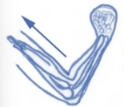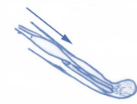MUSCULAR SYSTEM
1/64
There's no tags or description
Looks like no tags are added yet.
Name | Mastery | Learn | Test | Matching | Spaced |
|---|
No study sessions yet.
65 Terms
skeletal muscles
organs of the muscular system
most of them are attached to bone
functions of the muscular system
Locomotion
Posture
Respiration
Communication
Constriction
Heartbeat
Body heat regulation
nervous system
Primary coordinating and controlling system of the body
divided into central and peripheral
properties of muscle
Extensibility
Elasticity
Contractility
insertion
movable attachment of a muscle
origin
immovable attachment of a muscle
agonists
group of muscles producing an action
antagonists
opposing group of muscles
buccinator and epicranius
compresses cheeks inward
frontal belly
elevates eyebrows and wrinkles forehead
occipital belly
pulls scalp posteriorly
orbicularis oculi
closes eye
orbicularis oris
closes eye and puckers lips; shapes lips during speech
platysma
draws angle of the mouth inferiorly
zygomaticus
elevates corners of mouth (smiling)
elevates mandible
masseter and temporalis
trapezius
elevates clavicle
abducts and elevates scapula
extends head
rhomboid major and minor
adducts and elevates scapula
levator scapulae
elevates scapula
serratus anterior
depresses, protracts, and rotates scapula
pectoralis minor
depresses and protracts scapula
scapular muscles
stabilizes the scapula when the shoulder complex is loaded
moving and positioning the scapula to facilitate movement
pectoralis major
abducts, flexes, and medially rotates arm
deltoid
abducts, flexes, and extends arm
latissimus dorsi
adducts, extends, and medially rotates arm
teres major
same as latissimus dorsi
supraspinatus
abducts arm
laterally rotates arm
infraspinatus and teres minor
subscapularis
medially rotates arm
biceps brachii
rotates forearm and supination, also flexes arm
brachialis
flexes forearm
brachioradialis
flexes forearm
flexes forearm
brachialis and brachioradialis
triceps brachii
extends forearm, also extends arm
flexor carpi radialis
flexes and abducts wrist
flexor capri ulnaris
flexes and adducts wrist
palmaris longus
flexes wrist
extensor carpi radialis longus
extends and abducts wrist
extensor carpi ulnaris
extends and adducts wrist
extensor digitorum
extends fingers
rectus adonis
tightens abdominal wall; flexes the vertebral column
external and internal oblique
tightens abdominal wall
rotation and lateral flexion of the vertebral column
transversus abdominis
tightens abdominal wall
diaphragm
forms floor of thoracic cavity
depresses during contraction, causing inspiration
external intercostals
elevates and protracts ribs during inspiration
internal intercostals
depresses and retracts ribs during expiration
flexes thigh
illiacus and psoas major
gluteus medius
abducts and medially rotates thigh
tensor fasciae latae
flexes and abducts thigh
adducts, flexes, and laterally rotates thigh
adductor longus and adductor magnus
extends leg and flexes thigh
quadriceps femoris
rectus femoris
extends leg
vastus lateralis
vastus medialis
vastus intermedius
biceps femoris
flexes and laterally rotates leg
extends thigh
flexes and medially rotates thigh
semitendinosus
semimembranosus
gracilis
adducts thigh
flexes leg and locks knee
sartorius
flexes thigh and leg
abducts and laterally rotates thigh
gastrocnemius
plantar flexes foot and flexes leg
solenus
plantar flexes foot
fibularis longus
plantar flexes and everts foot
supports arch
tibialis anterior
dorsiflexes and inverts foot
extensor digitorum longus
dorsiflexes and everts foot
extends toes
concentric contraction
muscle shortens
produces tension while shortening to overcome external resistance

eccentric contraction
muscle lengthens
produces tension while lengthening
bringing weight down

isometric contraction
muscles stay the same length as they contract
ends of the muscles stay the same distance apart
stabilizing muscles hold parts of the body steady

periostium
at the bone where the fibers of the tendon are embedded